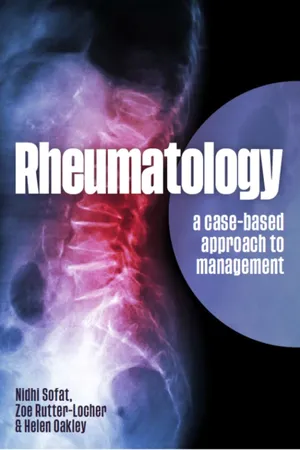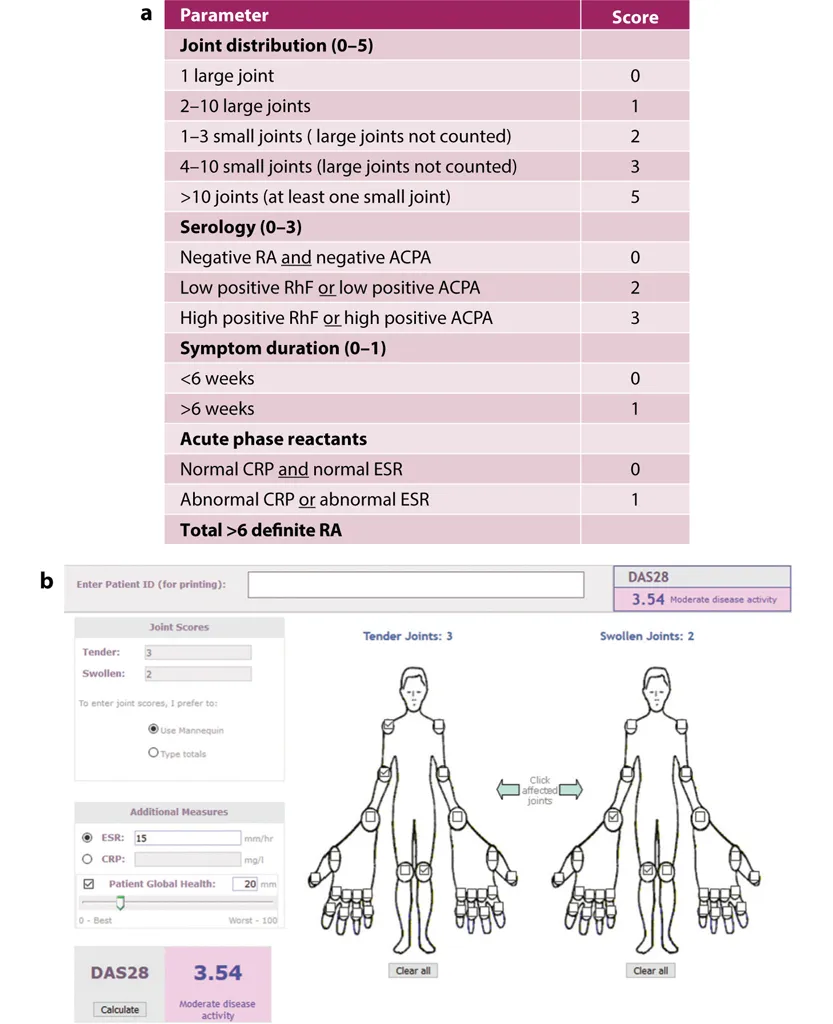
eBook - ePub
Rheumatology
A case-based approach to management
- 212 pages
- English
- ePUB (mobile friendly)
- Available on iOS & Android
eBook - ePub
About this book
A practical guide to the diagnosis and management of common rheumatic disorders, using real case histories.
Alongside the development of national and international guidelines for the management of rheumatic disorders, there has been a huge growth in the availability of new therapies. This book summarises diagnosis and patient management based around the latest guidelines and expanded treatment options, including the scientific rationale upon which these treatments are based.
To aid understanding, the book:
Alongside the development of national and international guidelines for the management of rheumatic disorders, there has been a huge growth in the availability of new therapies. This book summarises diagnosis and patient management based around the latest guidelines and expanded treatment options, including the scientific rationale upon which these treatments are based.
To aid understanding, the book:
- features real case histories to illustrate the range of clinical presentations and how these can be managed
- covers all common rheumatic disorders, from rheumatoid arthritis through crystal arthropathies to fibromyalgia and chronic pain conditions
- includes a dedicated chapter on paediatric rheumatology
- provides advice on physiotherapy including links to recommended video demonstrations
Frequently asked questions
Yes, you can cancel anytime from the Subscription tab in your account settings on the Perlego website. Your subscription will stay active until the end of your current billing period. Learn how to cancel your subscription.
At the moment all of our mobile-responsive ePub books are available to download via the app. Most of our PDFs are also available to download and we're working on making the final remaining ones downloadable now. Learn more here.
Perlego offers two plans: Essential and Complete
- Essential is ideal for learners and professionals who enjoy exploring a wide range of subjects. Access the Essential Library with 800,000+ trusted titles and best-sellers across business, personal growth, and the humanities. Includes unlimited reading time and Standard Read Aloud voice.
- Complete: Perfect for advanced learners and researchers needing full, unrestricted access. Unlock 1.4M+ books across hundreds of subjects, including academic and specialized titles. The Complete Plan also includes advanced features like Premium Read Aloud and Research Assistant.
We are an online textbook subscription service, where you can get access to an entire online library for less than the price of a single book per month. With over 1 million books across 1000+ topics, we’ve got you covered! Learn more here.
Look out for the read-aloud symbol on your next book to see if you can listen to it. The read-aloud tool reads text aloud for you, highlighting the text as it is being read. You can pause it, speed it up and slow it down. Learn more here.
Yes! You can use the Perlego app on both iOS or Android devices to read anytime, anywhere — even offline. Perfect for commutes or when you’re on the go.
Please note we cannot support devices running on iOS 13 and Android 7 or earlier. Learn more about using the app.
Please note we cannot support devices running on iOS 13 and Android 7 or earlier. Learn more about using the app.
Yes, you can access Rheumatology by Nidhi Sofat,Zoe Rutter-Locher,Helen Oakley in PDF and/or ePUB format, as well as other popular books in Medicina & Reumatologia, ortopedia e protesiologia. We have over one million books available in our catalogue for you to explore.
Information
01
Chapter 1
Rheumatoid arthritis
1.1 | Introduction |
Rheumatoid arthritis (RA) is the archetypal autoimmune disease, demonstrating activation of several inflammatory pathways that, without early treatment, results in end-organ damage focused around synovial joints. Since RA is a systemic disease, other organs can also be involved, including the lungs, heart, eyes and central nervous system. The condition has a worldwide prevalence of 1–2%. RA affects women 2–3 times more often than men. Although RA can present at any age, patients most commonly are first affected in the third to sixth decades of life.
In this chapter we discuss the diagnosis, pathophysiology and management of RA in the context of real-life clinical cases. The cases aim to demonstrate the breadth of clinical scenarios in which RA can present, with worked examples of diagnosis and management, particularly in the context of biologic therapies, which have revolutionised RA care worldwide.
1.2 | Diagnosis |
The diagnosis of RA has been aided by the development of classification criteria published in 2010 (EULAR/ACR criteria, see Aletaha et al., 2010). These include features that assist in confirming a diagnosis which is likely to require treatment (summarised in Figure 1.1). The features are based on:
•the pattern of joint involvement (joint distribution scores 0–5)
•the presence of autoantibodies (serology scores 0–3)
•the duration of symptoms, with >6 weeks’ duration of symptoms making the diagnosis more likely (symptom duration scores 0–1)
•the presence of raised inflammatory markers, including erythrocyte sedimentation rate (ESR) and C-reactive protein (CRP) (acute phase reactants scores 0–1).

Figure 1.1. EULAR/ACR classification and DAS28 scoring system
(a) EULAR/ACR 2010 classification criteria for rheumatoid arthritis; (b) DAS28 scoring system – a freely available online tool that can be used in the clinic to calculate the Disease Activity Score (DAS) based on 28 joints assessed clinically for swelling and tenderness (see www.4s-dawn.com/DAS28). Scores are entered in the tool, together with inflammatory markers ESR or CRP, with the patient global assessment of their disease on a 0–100mm scale. A numerical DAS28 score is then calculated and recorded.
Depending on the presence/absence of such classification criteria, the criteria define a score. The higher the score, the greater the likelihood of confirming RA which is likely to require treatment intervention to achieve symptom control; a score >6 means a definite diagnosis of RA.
Prominent features of RA in comparison to osteoarthritis include the diurnal variation of symptoms, with prominent early morning stiffness, joint swelling due to synovitis in a symmetrical distribution in the small joints of the hand, and evidence of a systemic inflammatory response measured on blood tests including CRP and ESR.
In the early stages of disease, plain X-rays of the hands and feet are often performed to assess the presence of erosions or osteopenia, which can be monitored with treatment. In addition, ultrasound or MRI may be helpful in confirming the clinical findings of joint swelling, including synovitis or early erosions, which are indicators of joint damage that is likely to require early intervention.
1.3 | Causes |
RA is an autoimmune condition that is characterised by the presence of autoantibodies to rheumatoid factor (RhF) and anti-citrullinated (anti-CCP or ACPA) antibodies. The presence of these antibodies often predates the development of RA joint features by many years.
The development of RA is believed to be a multistep process (Figure 1.2):
•a genetic background such as the presence of susceptibility genes including alleles of the major histocompatibility complex (MHC) genes e.g. HLA-DR4, HLA-DR and PTPN22
•epigenetic factors such as the presence of autoantibodies
•associated environmental risks such as periodontal disease and smoking.

Figure 1.2. The development of rheumatoid arthritis
The factors described above all raise the likelihood of developing RA.
RA often develops as a systemic disease (meaning that it can affect the whole body) with the loss of immune tolerance, ongoing production of autoantibodies, proliferation of lymphoid tissue and activation of dendritic cells. Stimulation of the adaptive immune system leads to activation of several proinflammatory pathways, with initiation of cytokine cascades leading to changes focused around joints that include synovitis, bone erosions, inflammation and pain.
Because RA is a multisystem autoimmune condition, many changes occur including vascular inflammation, pain, inflammation, osteoporosis and metabolic changes, which can lead to extra-articular involvement.
1.4 | Management |
Once the diagnosis has been established, care is based on rapid suppression of inflammation and pain based on the concept of ‘treat-to-target’.
1.4.1Non-pharmacological management
There is evidence supporting the role of early exercise therapy in RA, including for example hand therapy to strengthen and maintain muscles, tendons and ligaments, and physiotherapy. Exercise is recommended, including physiotherapy, hand therapy and occupational therapy (NICE guideline [NG100] Published date: July 2018).
1.4.2Pharmacological management
One of the early features of RA is pain and therefore pain management is a cornerstone of early treatment. Trial evidence shows that non-steroidal anti-inflammatory drugs (NSAIDs) are key to control early pain and inflammation. NICE guidance states that NSAIDs should be prescribed at the lowest dose possible for the shortest period of time in RA, ensuring that cardiovascular, renal and gastrointestinal risk factors are considered on a patient-by-patient basis (https://cks.nice.org.uk/nsaids-prescribing-issues#!scenario). NICE also recommends that gastroprotection in the form of a proton pump inhibitor (PPI) is cost-effective in people with conditions such as RA. In cases where several risk factors exist, e.g. cardiovascular, gastrointestinal in elderly patients, topical NSAIDs can be considered.
First-line therapy
First-li...
Table of contents
- Cover Page
- Half Title
- Full Title
- Copyright
- Contents
- Preface
- Abbreviations
- 1. Rheumatoid arthritis
- 2. Connective tissue disease
- 3. Crystal arthropathies
- 4. Psoriatic arthritis
- 5. Ankylosing spondylitis
- 6. Vasculitis
- 7. Osteoarthritis
- 8. Osteoporosis
- 9. Chronic pain disorders
- 10. Soft tissue disorders
- 11. Paediatric rheumatology
- Appendix
- Index